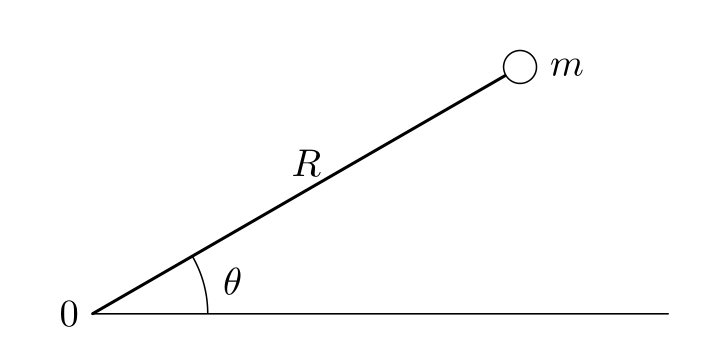I'm reading through "The Mechanical Universe" and I'm stuck with one exercise in the chapter about angular momentum. It goes like this:
A particle of mass $m$ is at the end of a rod of negligible mass and length $R$.
- If at any instance the rod makes an angle $\theta$ with the horizontal as it falls, calculate the torque about $0$ acting on the mass as it falls.
- If the mass is started from the vertical position ($\theta=\pi/2$) with initial speed $v$, find its angular momentum about $0$ as a function of $\theta$.
- Use your results to find the angular speed $d\theta/dt$ of the mass.
(FWIW, this exercise belongs to a section where angular momentum conversation hasn't been introduced yet, so I guess I'm not supposed to use that. Not that I knew how that would help...)
For the first point, I think we have the position $\vec{\mathbf r}$ of the mass and the gravitational force $\vec{\mathbf F}_g$ acting downward, so the torque is $\vec\tau = \vec{\mathbf r}\times\vec{\mathbf F}_g$ with magnitude $\tau = mRg\cos\theta$ as the angle between $\vec{\mathbf r}$ and $\vec{\mathbf F}_g$ is $\theta+\pi/2$. This makes sense as the torque would be zero for the vertical position and it would increase as the mass comes nearer to the bottom
But I have no idea how to address the second point. I guess "with initial speed $v$" means that the velocity is directed to the right (in the picture). But how does this affect the motion of the mass? What forces, apart from gravity, are acting on $m$? Is it the tension of the rod pulling the mass towards the center?
I was also wondering what would happen if there were no gravity: Let's suppose the picture is a view from above where $m$ is attached to the rod (which is fixed at $0$) and everything happens on a frictionsless table. If the mass were started with some initial velocity what would the outcome be? Would it circle around $0$ forever? That would contradict conservation of momentum, wouldn't it? But if it stopped moving, wouldn't that contradict conservation of energy?

